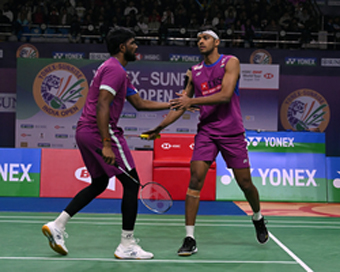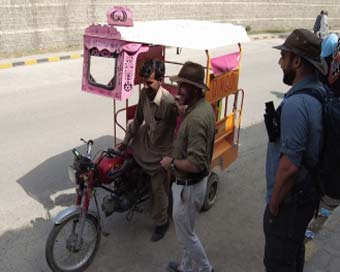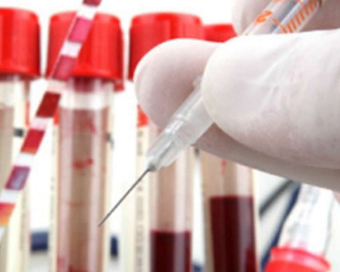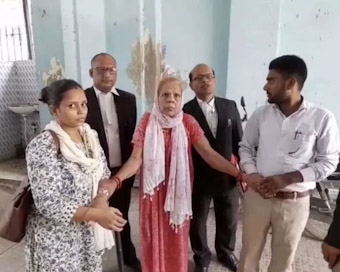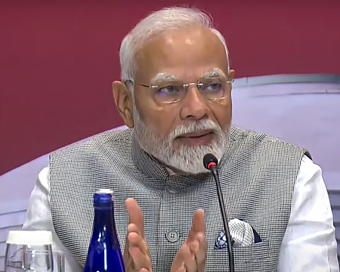 PM Modi visit USA
PM Modi visit USA Only the mirror in my washroom and phone gallery see the crazy me : Sara Khan
Only the mirror in my washroom and phone gallery see the crazy me : Sara Khan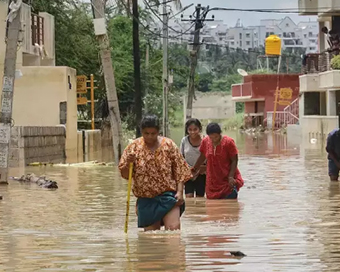 Karnataka rain fury: Photos of flooded streets, uprooted trees
Karnataka rain fury: Photos of flooded streets, uprooted trees Cannes 2022: Deepika Padukone stuns at the French Riviera in Sabyasachi outfit
Cannes 2022: Deepika Padukone stuns at the French Riviera in Sabyasachi outfit Ranbir Kapoor And Alia Bhatt's Wedding Pics - Sealed With A Kiss
Ranbir Kapoor And Alia Bhatt's Wedding Pics - Sealed With A Kiss Oscars 2022: Every Academy Award Winner
Oscars 2022: Every Academy Award Winner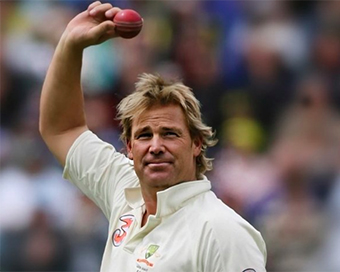 Shane Warne (1969-2022): Australian cricket legend's life in pictures
Shane Warne (1969-2022): Australian cricket legend's life in pictures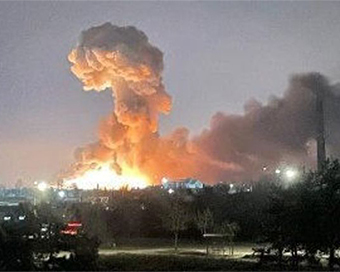 Photos: What Russia's invasion of Ukraine looks like on the ground
Photos: What Russia's invasion of Ukraine looks like on the ground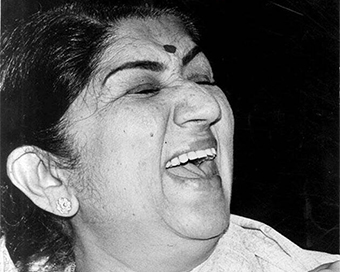 Lata Mangeshkar (1929-2022): A pictorial tribute to the 'Nightingale of India'
Lata Mangeshkar (1929-2022): A pictorial tribute to the 'Nightingale of India'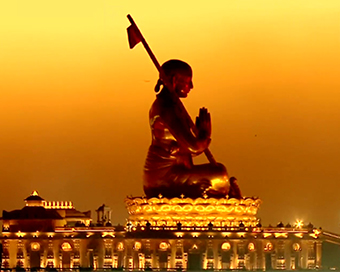 PM Modi unveils 216-feet tall Statue of Equality in Hyderabad (PHOTOS)
PM Modi unveils 216-feet tall Statue of Equality in Hyderabad (PHOTOS)The Badminton Association of India (BAI) has announced a 14-member-strong India squad for
- Men’s Sr Hockey Nationals to be played in division-based format from April 4
- Mensik denies Djokovic 100th title in Miami final
- KIPG: Son of a vegetable vendor, Bihar’s Jhandu Kumar eyes Worlds, 2028 Paralympics
- Hardik Singh credits hard work and team unity for receiving HI Midfielder of the Year award
- Djokovic, Alcaraz land in same half of Miami draw
6 challenges for the new UP government Last Updated : 17 Mar 2017 01:06:33 PM IST 
File photo: Prime Minister Narendra Modi
With 200 million people, equivalent to the population of Brazil, but with an economy the size of Qatars -- which has 2.4 million people, the same as the town of Bijnore -- the new government of Indias most-populous state Uttar Pradesh faces myriad problems.
The GDP of Uttar Pradesh is comparable to Kenya's, and its infant mortality rate rivals Mauritania, a poverty-ridden, west-African nation.
The Bharatiya Janata Party (BJP) won an unprecedented victory in the state in the 2017 assembly election, with 312 out of 403 seats, but with some of India's worst development indicators, there is much to do.
We analysed six major challenges and the corresponding promises made by the BJP to fix them in its election manifesto, called the""Lok Kalyan Sankalp Patra-201"".
1. Second-highest maternal mortality, half the child population stunted
Despite having the largest population, Uttar Pradesh spends Rs 452 per capita on health, 70 per cent less than the average spending by states.
One in two children in the state is not fully immunised, and it has Indi''s second-highest maternal mortality rate (258 deaths per 100,000 live births) and highest infant mortality rate (64 deaths per 1,000 live births), according to the National Family Health Survey, 2015-16 (NFHS-4).
There are 84 per cent fewer specialists than needed, 50 per cent fewer nursing staff, and the lowest share of health workers (19.9 per cent) in India.
As many as 46.3 per cent of the stat''s children are stunted (low height-for-age), 17.9 per cent are wasted (low weight-for-height) and 39.5 per cent are underweight, according to NFHS-4.
What the manifesto said: The BJP has promised to have a primary sub centre in all villages with the latest equipment and technology. Further, it promised to set up 25 new medical colleges and specialty hospitals and one hospital at par with the All India Institute of Medical Sciences in every six blocks.
The BJP has promised a malnutrition-free state in five years.
2. Low learning levels, high absenteeism
Uttar Pradesh has achieved high enrolment of children in primary school, with 83.1 per cent of primary school-aged children enrolled in in 2015-16, according to the data from the governmen''s Unified District Information System for Education (U-DISE).
Major issues for the new government now include low learning outcomes, high absenteeism, and lower enrolment in grade VI and further -- 60.5 per cent of upper-primary school-aged students enrolled in school in 2015.
In 2016, about half (49.7 per cent) of Grade I students surveyed in households could not read letters, while 44.3 per cent could not recognise numbers up to nine, according to the Annual Status of Education Report (ASER), a citizen-led assessment of learning in rural India.
The survey also found that a little over half of students (56 per cent) were present in primary school on the days of the survey.
What the manifesto said: It majorly concentrates on inputs - free education, books, uniforms, teacher-student and classroom-student ratios, along with laptops and free internet for college students, and a Rs 500 crore scholarship fund for poor students.
3. High youth unemployment, high migration for jobs
The low quality of education in the state (and dearth of jobs) is reflected in high unemployment. In 2015-16, more people per 1,000 were unemployed (58), compared to the Indian average (37). Youth unemployment was especially high, with 148 for every 1,000 people between the ages of 18 and 29 years unemployed, compared to the Indian average of 102, according to 2015-16 Labour Ministry data.
Between 2001 and 2011, over 5.8 million people between the ages of 20 and 29 years migrated in search of jobs, but, for most of these migrants, low educational attainment likely resulted in low-paying jobs in the informal sector.
Voters recognise the lack of jobs as a major issue in the state. As many as 20 per cent of voters surveyed said jobs were the most important issue this election year, according to a FourthLion-IndiaSpend survey.
What the manifesto said: The BJP government will create seven million jobs or opportunities for self-employment in the next five years, its manifesto said. As many as 90 per cent of all jobs in industries will be reserved for local youth. The manifesto also promises Rs 1,000 crore for a start-up venture capital fund, which will also create jobs for the youth.
4. Industrial growth one of slowest in country
Uttar Pradesh reported an annual industrial growth (2004-05 constant prices) of 1.95 per cent and 1.93 per cent in 2013-14 and 2014-15 respectively, according to the NITI Aayog -- among the bottom five in the country.
The state is struggling even in industries that have traditionally been strong. For instance, Kanpu''s leather industry is in deep distress with 146 of its 400 leather tanning units shutting down in 10 years.
Uttar Pradesh ranked 20th out of 21 states on the 2016 State Investment Potential Index, a ranking of states on labour, infrastructure, economic climate, political stability, governance, and perceptions of a good business climate.
The index, released by the National Council for Applied Economic Research, identifies a shortage of electricity and vocationally-trained people as the main concern in the state.
What the manifesto said: It promises to triple current investment by the creation of an investment board. Further, it calls for a single-window clearance department, headed by the Chief Minister, for industries. The manifesto also promises to build six IT parks, a pharmaceutical park, and a dry port connected to a sea port to encourage exports.
5. 20% of Indi''s agri households, but slow agri growth
By 2012-13, Uttar Pradesh, with an estimated 18.05 million agricultural households, made up 20 per cent of Indi''s total agricultural households. Three out of four rural households depend on agriculture, making agricultural reforms a key agenda in one of Indi''s most fertile belts.
For the nine years between 2004-05 and 2012-13, the agriculture and allied sector recorded the slowest compounded annual growth rate of 2.9 per cent, below the national growth rate of 3.7 per cent.
The state recorded a growth rate of 4.2 per cent in agriculture and allied activities (constant 2004-05 prices), slower than Uttarakhand, which recorded a growth rate of 5.12 per cent, and Madhya Pradesh, which grew at 18.85 per cent, in 2014-15.
Outstanding farmer loans stood at nearly Rs 75,000 crore as of two years ago. Of these, a little more than 10 per cent, or Rs 8,000 crore, was loaned through state cooperative banks or primary agricultural credit societies, which are the only loans that the newly formed government can choose to waive off -- the other loans are controlled by scheduled commercial banks. This amount includes loans to all farmers in the state, and not just small and marginal farmers.
What the manifesto said: It promises that all agricultural loans will be waived off for small and marginal farmers, while future loans will be provided interest-free. The new government will also create a roadmap to double agricultural income in the state by 2022.
Further, it promised to pay sugarcane farmers in the largest sugarcane-producing state within 14 days of sale, while also coordinating with mill owners and banks to repay previously-owed amounts to sugarcane growers within 120 days of forming the new government.
6. More than half the households unelectrified
In Uttar Pradesh, power cuts were the leading election issue for one-third of voters polled. It remains one of Indi''s most poorly electrified states -- with 51.8 per cent of rural households unelectrified -- despite having the third-largest installed coal capacity in the country by end-January 2017.
Corruption and red tape within electricity distribution companies, which are responsible for the timely disbursal of funds for electrification projects, are a major factor in the lackadaisical progress of electrification across the state.
What the manifesto said: Every household in the state will be provided with 24-hour power supply, while poor households (below the official poverty line of Rs 816 per capita per month for rural areas) will be given electricity connections free of cost. Poor households will also be provided the first 100 units of electricity at a discounted rate of Rs 3 per unit.IndiaSpend Team For Latest Updates Please-
Join us on
Follow us on








172.31.16.186

